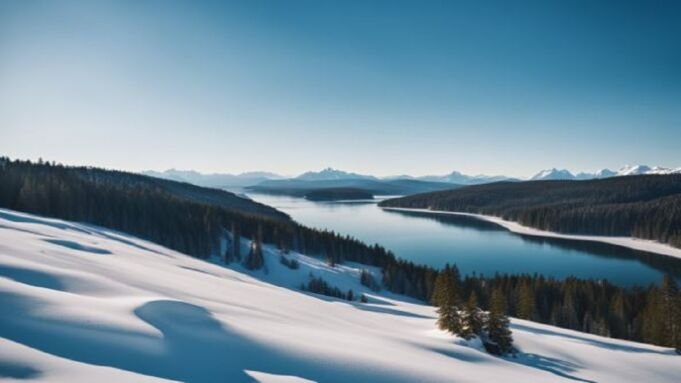Are you curious about which countries are the coldest on the planet? If you’re a winter enthusiast, discovering the nations that endure the lowest temperatures on earth could be fascinating. In this blog post, I will share the 12 coldest countries worldwide.
From Canada to Kazakhstan, these countries are known for their frigid temperatures and extreme weather conditions. If you’re planning a winter vacation or simply curious about the coldest places on earth, keep reading to learn more about these countries and what makes them unique.
In this blog post, you’ll learn the average temperatures of each country, what it’s like to live in such cold conditions, and what activities you can do in these countries during the winter season. So grab a warm cup of tea and get ready to learn about the 12 coldest countries in the world.
1. Russia
Russia, the largest country in the world, also ranks among the coldest. Spanning two continents, Europe and Asia, it hosts some of Earth’s most frigid inhabited locations.
Winter months see average temperatures around -20°C (-4°F), with specific areas plunging to -50°C (-58°F). The northernmost Siberia is notorious for its severe cold, with temperatures dropping to -67.8°C (-90°F) and landscapes permanently blanketed in snow.
Residents of Siberia have adapted to these harsh conditions over centuries, embracing the extreme climate. Despite the freezing weather, Russia boasts a beautiful landscape, rich history, and vibrant culture. Landmarks like Moscow’s Red Square, St. Petersburg’s Hermitage Museum, and the world’s deepest lake, Lake Baikal, are just a few of its many attractions.
Planning a winter visit requires warm clothing and accessories, including hats, gloves, and scarves, alongside staying hydrated and limiting time spent in the cold. However, summer offers milder weather and various outdoor activities, such as hiking, camping, and exploring, making it a preferred time for tourists.
2. Canada
Canada is known for being one of the coldest countries in the world, with an average annual temperature of -22.37°F. The country is sparsely populated, with only four people per square kilometer. In winter, the snow-clad streets of Montreal, Canada, are a sight.
The country’s cold climate creates unique challenges for its residents. Canadians have adapted to the cold weather by creating indoor activities such as hockey, curling, and ice skating. Additionally, Canada is home to some of the world’s best ski resorts, attracting tourists worldwide.
Canada’s climate also affects its wildlife. The country is home to many species of animals that have adapted to the cold weather, such as the polar bear, the Arctic fox, and the caribou. These animals have unique adaptations that allow them to survive in the harsh Canadian winter.
Despite the challenges that come with living in such a cold country, Canadians take pride in their winter traditions and have learned to embrace the cold weather. The country’s natural beauty and unique winter activities make it a popular tourist destination, especially during winter.
3. Greenland
Greenland is an autonomous country with the self-governance kingdom of Denmark, the world’s largest island located in the northern part of North America. The government is known for its vast ice sheet and glaciers, making it one of the coldest countries in the world. The island’s coldest temperature recorded one °C (−87.0 °F) in 1954.
Greenland has a population of approximately 56,000 people, and most of them are either Inuit or of Danish descent. The country’s capital, Nuuk, is located on the southwestern coast and is the largest city in Greenland. Despite its frigid climate, Greenland is home to a variety of wildlife, including polar bears, reindeer, and whales.
The economy of Greenland is heavily dependent on fishing and hunting, as well as on financial support from Denmark. The country has a unique culture, with traditions and customs that have been passed down for generations. The Inuit people of Greenland have a rich history and have developed a strong connection with the land and sea.
Greenland is also a popular destination for tourists who are looking to experience the country’s natural beauty and unique culture. Visitors can explore the country’s rugged terrain, hike through its national parks, and witness the stunning Northern Lights. Despite its extreme climate, Greenland offers a one-of-unique experience for those who brave the cold.
4. Iceland
Iceland, a Nordic country, captivates with its breathtaking winter landscapes, glaciers, and waterfalls. Known as one of the coldest countries, it has a mean annual temperature of 35.15°F. This chilly climate, however, does not deter tourists, especially in winter, when the Northern Lights become a magnificent spectacle.
During these months, visitors enjoy activities like ice caving, glacier hiking, and skiing. A remarkable aspect of Iceland is its reliance on geothermal energy.
Harnessing this power, the country efficiently heats buildings, homes, and swimming pools, showcasing its dedication to sustainability and environmental protection.
5. Finland
Finland, nestled in the northern part of Europe, experiences some of the coldest weather. With an average temperature of 36.54°F (2.52°C), it ranks among the world’s chilliest countries. Dark and long winters are characteristic, often snowing the ground for half the year. The Northern Lights, a spectacular natural phenomenon, illuminate the winter skies here.
Winter sports enthusiasts find Finland a haven, offering skiing, snowboarding, and ice skating. Another unique tradition is “Avanti,” a refreshing dip in ice-cold water following a sauna session, embraced by many locals for its health benefits.
The country’s natural beauty is unparalleled, featuring vast national parks, lakes, and forests. Lake Saimaa, the largest lake, offers stunning landscapes in the southeast. The Arctic Circle, cutting through Finland, attracts tourists eager to witness the summer’s midnight sun when daylight extends through the night.
6. Sweden
Sweden is a Nordic country located in Northern Europe. It is the third largest country in the European Union by area and has a population of around 10 million people. The country is known for its beautiful landscapes, rich history, and vibrant culture. However, it is also known for its extremely cold winters, making it one of the coldest countries in the world.
The average temperature in Sweden during the winter months is around -7°C (19°F). However, temperatures can drop as low as -40°C (-40°F) in the country’s northern parts of the cold; Swedes have found ways to embrace the winter months and enjoy outdoor activities such as skiing, ice skating, and ice fishing.
One of the unique winter experiences is at Swe Icehotel, located in the small village of Jukkasjärvi. The hotel is built entirely out of ice and snow and is reconstructed every winter. Visitors can sleep in one of the hotel’s ice rooms, go ice sculpting, or take a dip in the hotel’s ice bath.
Another popular winter activity in Sweden is the Aurora Sky Station in Abisko National Park. The station is known for its stunning views of the Northern Lights, which can be seen from September to April. Visitors can take a chairlift to the station and enjoy a warm meal while gazing at the breathtaking natural phenomenon.
In addition to its winter activities, Sweden is also known for its delicious cuisine. Traditional Swedish dishes include meatballs, gravlax, and lingonberry jam. The country is also home to many Michelin-starred restaurants, including Frantzén in Stockholm, which has three stars.
7. Norway
Norway is celebrated for its fjords, mountains, and northern lights and stands as one of the coldest countries globally. Its climate ranges from cold and temperate to long, chilly winters and brief, mild summers. Winter temperatures average around -6°C (21°F), but northern regions can experience lows of -40°C (-40°F). The coldest recorded temperature, -51.2°C (-60.16°F), was measured in Karasjok in January 1999.
The country’s infrastructure, including roads, railways, and airports, is robust, ensuring smooth functioning despite the freezing temperatures. Norwegians equip themselves with warm clothing and gear to combat the cold.
Visiting Norway offers many winter activities like skiing, snowboarding, and dog sledging. The northern lights, visible from September to April, remain a spectacular draw for tourists seeking the magic of these celestial dances.
8. Mongolia
Mongolia stands out as a top contender among the world’s coldest countries, with winter temperatures averaging -22°F (-30°C). Its weather, ranging from -40°F (-40°C) to 104°F (40°C) throughout the year, adds to the country’s uniqueness—the vast, open landscapes combined with the severe cold present a formidable living environment.
Nomadic communities have long adapted to these conditions, many residing in traditional yurts, or gers, built to endure the chilly weather.
The country’s beauty lies in its rich culture and history, alongside stunning natural wonders such as the Gobi Desert, the Altai Mountains, and Khövsgöl Lake. Mongolia’s wildlife is equally fascinating, home to species like the Mongolian wild horse, the snow leopard, and the Bactrian camel.
Travellers to Mongolia must prepare for the cold by packing warm clothing, including layers, a quality coat, hat, gloves, and boots. Bringing a sleeping bag is advisable for those staying in a ger, ensuring warmth during the cold nights.
9. Kazakhstan
Kazakhstan is the world’s second-coldest country and is famous for its severe winters. A continental climate dominates, featuring long, bitter winters and brief, sweltering summers. Winter temperatures can plunge to -40°C, placing Kazakhstan among the Earth’s chilliest regions.
Throughout the year, the country witnesses extreme temperature shifts. Its northern areas endure the brunt of the cold, with mercury levels falling to -50°C during winter months. Conversely, the south enjoys warmer conditions, with summer temperatures hovering between 20°C and 30°C.
The “devil’s breath,” a term for Kazakhstan’s fierce winds reaching speeds up to 90 km/h, exacerbates the cold, making it feel even more biting.
Kazakhstan’s landscape, covered in vast steppes, snowy peaks, and ice-bound lakes, offers breathtaking natural beauty. It serves as a sanctuary for unique fauna, including the rare snow leopard and the saiga antelope.
This nation boasts natural wonders and a rich cultural tapestry woven through influences from Mongols, Turks, and Russians over the centuries. Its music, dance, and culinary traditions reflect a rich cultural heritage that continues to thrive amidst its harsh climate.
10. Antarctica
Antarctica, Earth’s coldest continent and the fifth-largest by land area, stands out as the driest place, receiving only 1-3 cm of precipitation annually. Temperatures here can plummet to -90 °C (-130 °F), claiming the title of Earth’s coldest spot.
The continent houses the South Pole, Earth’s southernmost point, nestled at its centre and encircled by the Antarctic ice sheet. This massive ice formation, spanning 14 million square kilometres, ranks globally as the largest single ice mass.
Rich in exploration history and scientific research, Antarctica captivates with its unique landscape and wildlife, including penguins, seals, and whales. Scientists worldwide flock here to study climate change, geology, and astronomy, among other subjects.
Though faced with extreme conditions, Antarctica is not entirely devoid of human presence. Several research stations dot the landscape, operated by countries for scientific exploration. These stations house small teams of researchers and support staff, braving the continent’s severe weather to advance their scientific missions.
11. Kyrgyzstan
Kyrgyzstan is one of the coldest countries in the world, with an average temperature of -6.6°C (20.1°F). The country is located in Central Asia, known for its rugged terrain and stunning natural beauty.
During the winter months, temperatures can drop as low as -30°C (-22°F), making it one of the harshest environments on the planet. Despite the extreme cold, the people of Kyrgyzstan are known for their warmth and hospitality, making it a popular destination for adventurous travelers.
Kyrgyzstan is home to some of the most beautiful mountain ranges in the world, including the Tien Shan and Pamir Mountains. These mountains are covered in snow throughout the year and provide a stunning backdrop for the country’s many outdoor activities, such as skiing, snowboarding, and hiking.
In addition to its natural beauty, Kyrgyzstan is also known for its rich history and culture. The country has a long and fascinating history, with evidence of human habitation dating back to the Paleolithic era. Today, visitors can explore the country’s many museums, ancient ruins, and historic sites, such as the Burana Tower and the Tash Rabat Caravanserai.
12. Tajikistan
Tajikistan, nestled in Central Asia, covers an area of 143,100 square kilometres and ranks as one of the coldest countries worldwide. The average temperature hovers around 6.3°C (43.3°F), with winter lows reaching -27°C (-17°F), mainly due to its mountainous terrain, which contributes to the chilly climate.
From November to February, winter brings sub-zero temperatures, heavy snowfall, and transportation challenges. This season also impacts the economy, particularly limiting agricultural activities.
Yet, Tajikistan’s cold climate belies its scenic beauty and tourist appeal. The Pamir Mountains, part of the majestic Himalayan range, provide stunning vistas, while the Fann Mountains in the west attract visitors with their natural beauty. Among its many lakes, Iskanderkul Lake stands out for its picturesque landscape, adding to the country’s allure for tourists.
Frequently Asked Questions (FAQs)
What are the top ten coldest countries on Earth?
The top ten coldest countries on Earth, in order of average annual temperature, are as follows: Antarctica, Russia, Canada, Greenland, China, United States, Mongolia, Kazakhstan, Finland, and Iceland. These countries all experience extremely cold temperatures due to their high latitudes and/or elevations.
Which country experiences the longest winter season?
In some regions, Russi experiences the longest winter season, lasting up to six months. The country’s vast size and location in the northern hemisphere contribute to its long, harsh winters.
What country holds the record for the lowest temperature ever recorded?
The coldest temperature ever recorded on Earth was in Antarctica, specifically at the Soviet Union’s Vostok Station on July 21, 1983. The temperature reached a bone-chilling -128.6 degrees Fahrenheit (-89.2 degrees Celsius).
Can you list some of the coldest places on Earth?
Some of the coldest places on Earth include Oymyakon in Russia, which holds the record for the coldest inhabited place on Earth with a temperature of -96.2 degrees Fahrenheit (-71.2 degrees Celsius), and Verkhoyansk, also in Russia, which holds the record for the greatest temperature range on Earth, from -90 degrees Fahrenheit (-67.8 degrees Celsius) to 98 degrees Fahrenheit (36.8 degrees Celsius).
How do the coldest countries in the world compare in terms of average temperatures?
The world’s coldest countries have average temperatures ranging10 degrees Celsius to -50 degrees Celsius. These countries experience extreme cold due to their high latitudes, long winters, and/or high elevations.
What are some of the factors that contribute to a country’s cold climate?
Several factors contribute to a country’s cold climate, including its latitude, elevation, proximity to bodies of water, and prevailing winds. Countries located in high latitudes and/or elevations tend to experience colder temperatures, while those located near bodies of water and/or affected by prevailing winds may experience milder temperatures.















